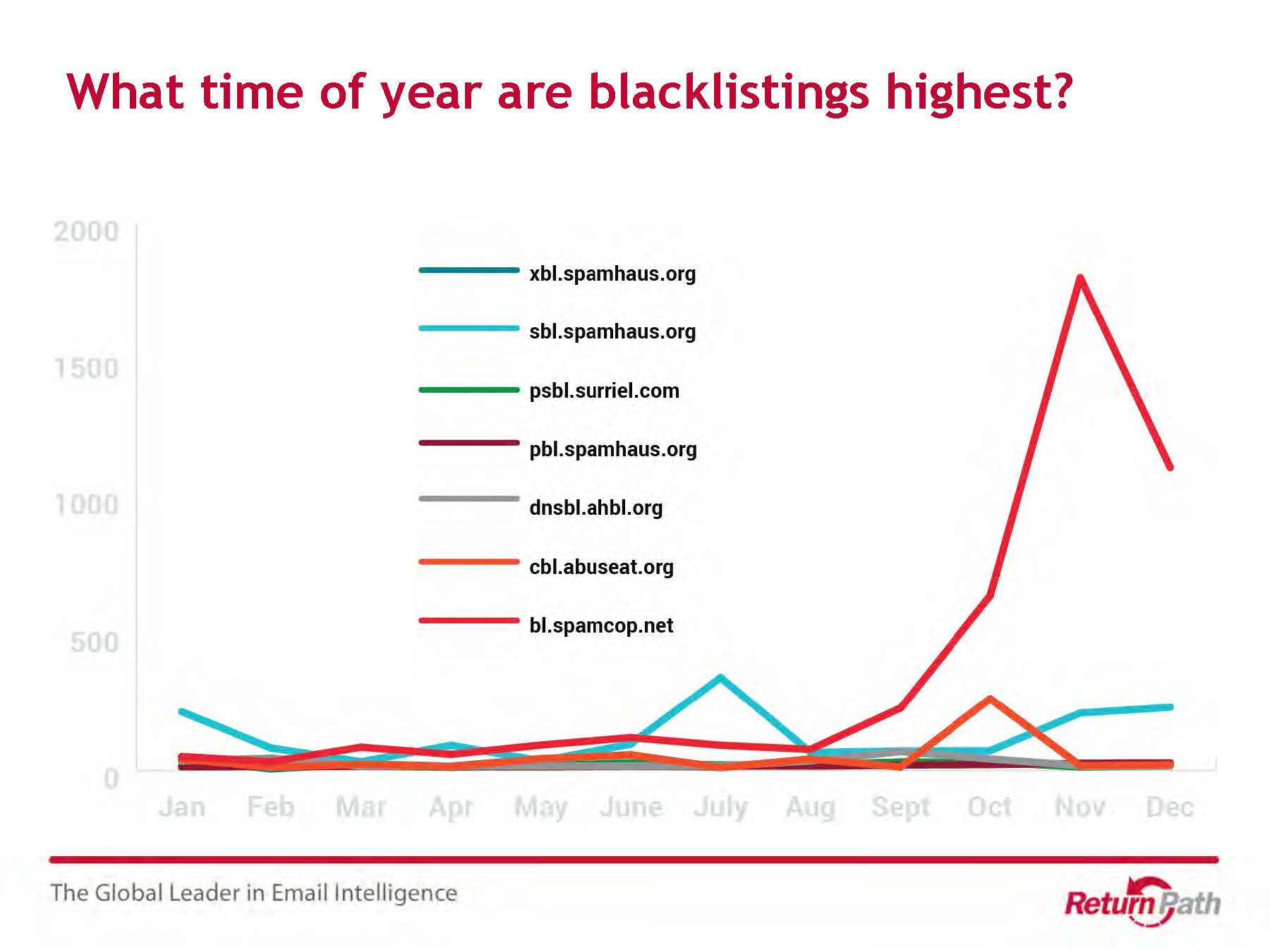Blog
CATEGORY: email-marketing
Dealing with the email marketing Grinch

It is the most wonderful time of the year in email marketing as B2C marketers deploy a frenzy of long-planned campaigns and B2B marketers contend with the quick switch from end of year targets to the corporate Christmas card campaign. It’s not a wonderful time of year in the wild and crazy world of email deliverability though. As the volume of email marketing hits its annual high, the email marketing Grinch; the spam filter also goes into overdrive…

This isn't a new thing either. The above slide is from an old presentation by Return Path showing a seasonal peak in blacklistings – the email equivalent of Santa’s naughty list. Blacklistings are often a) temporary and b) harsh. A few people marking your email as spam can upset your entire email marketing efforts.
This particular Grinch is not some green-furred malcontent though, it is just a machine, doing what it has been programmed to do – to protect an inbox. The more you know about how the machine works, the more effective your campaigns can be. There are three core components to avoiding spam filtration countermeasures:
Content
The older spam filtration methodologies of avoiding certain words and phrases are still relevant, but the most important aspect nowadays are links. Spam filters can look several layers deep from your email to your website and in turn to other destinations. It’s a difficult thing to check manually, so we have tools built into e-shot to check your link list twice and work out what is naughty and what is nice.
Reputation
This is the technical bit; sending domains and IP addresses. DMARC and SPF records. It’s complex, it’s boring. It’s the stuff we look after, so that you don’t have to worry.
Behaviour
This one is increasingly acknowledged as the most important, yet least well understood aspect of deliverability. In simple terms, the more positive behaviour your email has, the better. If there is a negative response, that’s not so good.
Now when you think about positive behaviour with your email, you probably think ‘clicks’ – that’s surely a good sign? Well, unfortunately not from a spam filter perspective, as tracking that particular behaviour has implications on their own privacy policies. Let’s look at some good behaviours that will keep you on the nice list:
Opens
The most obvious positive action that spam filters look for are when someone opens your email. What quite often happens when very large campaigns are sent is that a spam filter or ISP will only let a certain amount of emails through and wait to see if recipients open them. If they see lots of opens, the rest will be let through. This works cumulatively as well, so if you are sending to large numbers of recipients who never open your emails, over time, you are likely to see a decline in inbox placement generally. You may end up in junk folders or your emails being flagged as spam. A good tip is to review your audience and segment your data by whether they are engaged with your communications or not. You can then try different things with those who are not reading your emails.
Replies
If your audience is small enough and targeted, a great way to boost your sending reputation is to encourage recipients to reply to your email. This is especially effective in B2B email marketing where plain, seemingly personal emails can elicit a good response. These emails look like the kind of emails that you would send to a colleague or customer direct from your own email client. It is easier to reply to an email directly than it is to go to a web page, fill in a form, accept a privacy policy and then await the thing that was promised to you in the original email!
That’s not practical if you have very large audiences, but dynamic content can also help with this. You can use a value associated with each contact to direct replies to a specific team member. For customer marketing, this may be to an account manager. For prospecting campaigns, it could be to the relevant salesperson.
Forwards
When recipients forward your email, it is also a reassuring sign to the dark forces of spam filtration that you are a legitimate sender. The forward to a friend function has been a mainstay in email marketing for many years, but forwarding is something that most will do from the standard controls within their email client. In practical terms, what is in your email that makes it shareable with friends or colleagues? An offer code? An exclusive download? Don’t be afraid to suggest that recipients forward your emails if there is good reason to do so.
Mark as ‘not junk/spam’
This is one of the strongest signs that you can give to a spam filter that you are a legitimate sender, but also one of the hardest as you’re already on the naughty list. There’s no easy approach to this other than manually contacting recipients and asking them to fish you out of their quarantine folder. You won’t have to do it for everyone, but the more people do it, the more likely the rest of your emails will be sent to the inbox next time.
More help
Deliverability is a hugely complex area and there is a lot more to it than we can fit in this post. The simple advice to all marketers is send emails that have a better chance of eliciting positive behaviour. That tends to mean being more targeted. If you would like to learn more about modern ways to make your email marketing more targeted, you might be interested in our learning programme that starts in January where we will be looking at segmentation and targeting in detail.
If you’ve been experiencing issues with deliverability, our consultants can also help you to identify issues and formulate a plan to improve it. To find out more about that, get in touch.
Solutions
Email marketing healthcheck
We are confident that we can help you, which is why we offer a free healthcheck to identify potential issues with your current programme and free advice on things that could be done to improve it.